Silicon Valley gangs, crypto wealth, and the US vice presidency: Peter Thiel's power network
- 核心观点:逆向思维与长期布局创造财富与权力。
- 关键要素:
- 2014年低价买入比特币,2022年高位清仓。
- 投资PayPal前同事,构建硅谷权力网络。
- 创办Palantir,绑定美国政府与军工业。
- 市场影响:影响加密市场周期与政策走向。
- 时效性标注:长期影响。
Original author: David, TechFlow
“ What important truth do very few people agree with you on ?”
This is Peter Thiel's favorite question to ask during interviews, and it is also the opening line of his best-selling book "Zero to One".
If you ask him this question, the answer might be:
In 2003, when everyone was working on social networks, he chose to do data analysis for the CIA;
In 2014, when Bitcoin fell to $400, he bought $20 million;
In 2022, when everyone was shouting "Bitcoin $100,000", he cleared all his holdings.
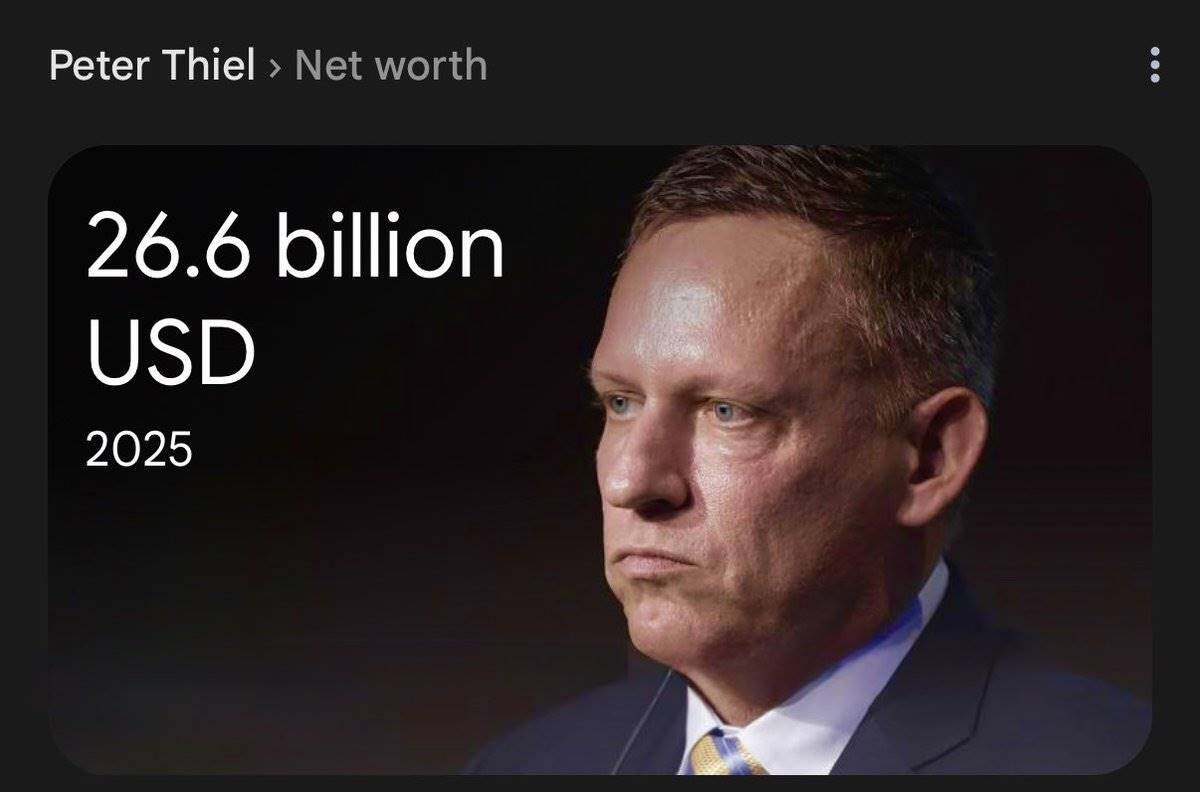
Today, 57-year-old Peter Thiel has a fortune of $26.6 billion.
Palantir, the company he founded, has a market capitalization of $400 billion. He has made $2.5 billion from cryptocurrency investments, including investments in the recently popular cryptocurrency BMNR and the publicly listed cryptocurrency exchange Bullish.
And JD Vance, whom he trained, has become the Vice President of the United States.
But looking at Silicon Valley, he is still an outlier:
A billionaire who openly supports Trump, a tech entrepreneur who works for intelligence agencies, and an investor who sells when everyone else is buying.
This is a story about how reverse thinking creates wealth and how patience turns into power.
PayPal palace drama
In December 1998, 31-year-old Peter Thiel and 23-year-old Max Levchin founded Confinity in Palo Alto. Around the same time, Elon Musk founded X.com.
The two companies were engaged in a cash-burning war, each vying to dominate online payments. Three months later, the two companies merged to form PayPal, with Musk as CEO.
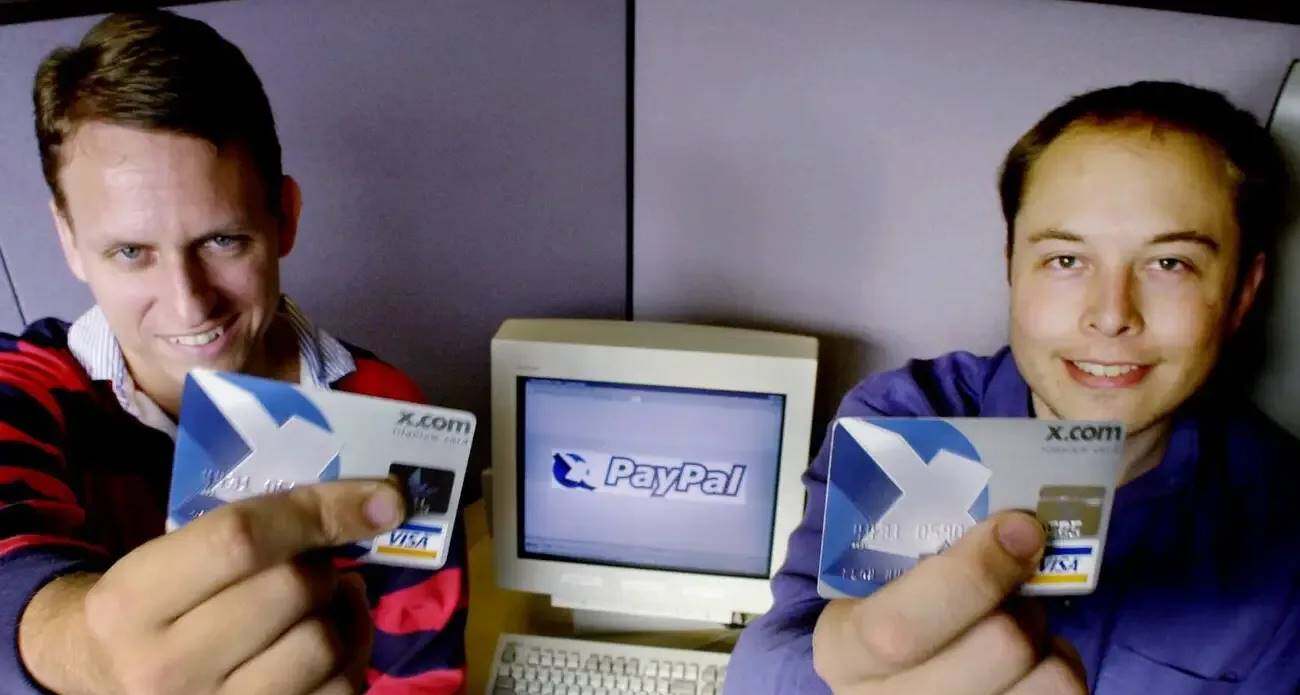
But the honeymoon period lasted only six months. In September 2000, while Musk was on vacation in Australia, the company's board of directors voted to remove Musk from the CEO position and replaced him with Thiel.
The ostensible reason for the dismissal was a technical disagreement: Musk wanted to migrate the system from Unix to Windows. But the deeper reason was a fundamental disagreement between the two on the direction of the company: Musk wanted to build a comprehensive financial services platform, while Thiel wanted to focus on payments.
This is one of the most famous palace intrigues in Silicon Valley history, and Thiel's coup was masterfully executed. He chose to launch it when Musk was not present, enlisted the support of Max Levchin, then PayPal's technical director, and framed the power struggle with technical justification.
After the change of leadership, PayPal focused on payment business, quickly achieved profitability, and was sold to eBay for US$1.5 billion in 2002.
As the largest individual shareholder, Thiel cashed out $55 million, which became his first pot of gold in the investment world.
Former investment colleagues
More than two decades later, when people talk about Silicon Valley’s power structure, they can’t avoid the fact that many of the most influential people once worked in the same office at the same company.
And the owner of that office is Peter Thiel.
After the acquisition of eBay was completed in October 2002, Thiel founded the investment fund Founders Fund with the $55 million cashed out from PayPal.
His first batch of investments were almost all former PayPal colleagues, a group that later became known as the "PayPal Mafia":
When Reid Hoffman founded LinkedIn, Thiel was the first outside investor, investing $500,000. When Chad Hurley and Steve Chen were tinkering with YouTube, Thiel participated in its early funding. When Jeremy Stoppelman wanted to start Yelp, the local review site, Thiel provided the first seed round...
The most interesting thing is his relationship with Musk. After the "coup" in 2000, the two ostensibly parted ways.
But in 2008, when SpaceX was on the verge of bankruptcy and its fourth launch failure could have spelled the end of the company, Founders Fund led a $20 million investment, which kept SpaceX afloat until it secured the NASA contract.
Investing in former colleagues' businesses also led to significant success for Founders Fund. YouTube was acquired by Google for $1.65 billion, LinkedIn's peak market capitalization exceeded $26 billion, and SpaceX's current valuation exceeds $200 billion.
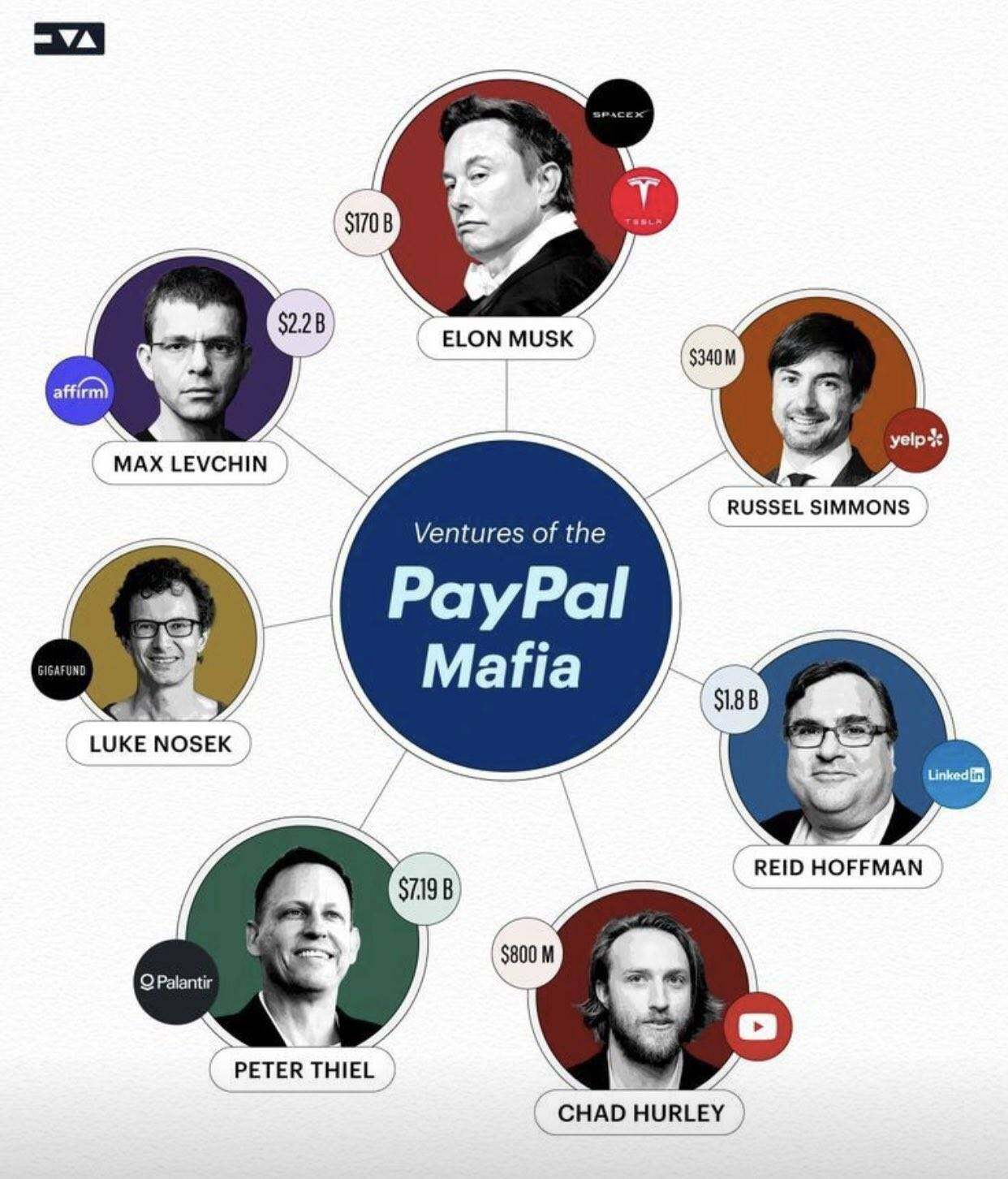
But what Thiel really cares about doesn't seem to be money. The "PayPal Mafia" gradually controls half of Silicon Valley.
Reid Hoffman has become Silicon Valley's "super connector," with nearly every entrepreneur relying on him for connections. David Sacks, who transitioned from entrepreneur to podcast host, whose "All-In" podcast influences public opinion throughout the tech world, is even the White House's crypto czar. Musk, from Tesla to SpaceX to X, has practically defined the technological ambitions of this era.
What’s even more amazing is that this network has a loyalty that goes beyond business.
In 2016, when Thiel was singled out by Silicon Valley for his support of Trump, members of the PayPal mafia remained silent. They may have disagreed with his choices, but no one retaliated.
By 2024, when Thiel was pushing JD Vance to run, David Sacks not only donated money but also publicly endorsed him on a podcast.
Every investment Peter Thiel makes adds a node to his power network, and every successful investment exit makes this network stronger.
Bet on Facebook and sell it when it goes public
In the summer of 2004, 20-year-old Harvard dropout Zuckerberg also found Thiel.
At the time, Facebook had just surpassed 1 million users, and the social networking market was already crowded: Friendster had 7 million users and MySpace had 5 million.
Mainstream investors in Silicon Valley were not optimistic about Facebook, but Thiel asked Zuckerberg a question:
“What’s the difference between Facebook and MySpace?”
"On Facebook, you have to use your real name," Zuckerberg replied.
It was this seemingly simple difference that led Thiel to make his judgment. He later wrote in his book "Zero to One": Real identity means trust, and trust means real social relationships, not virtual numbers of fans.
In September 2004, Thiel personally invested $500,000 in Facebook for a 10.2% stake. The terms of this investment were surprisingly simple: no board seat requirements, no liquidation preferences, and not even any anti-dilution provisions.
The following story proved his judgment. In 2005, when Accel Partners invested at a valuation of $127 million, other VCs realized what they had missed. By 2007, Microsoft had invested at a valuation of $15 billion, and Facebook had become a phenomenal product.
In May 2012, Facebook went public, opening at $38. While most early investors held on, Thiel sold 16.8 million shares on IPO day, cashing out approximately $640 million. He continued to reduce his holdings in the following months, ultimately turning his initial $500,000 investment into a profit exceeding $1 billion, a return on investment exceeding 2,000 times.
Facebook's stock price did rise to over $300, suggesting Thiel failed to maximize his investment. However, just two years after Thiel cashed out, in 2014, the price of Bitcoin fell to $400.
On one side are the star stocks that everyone is chasing, and on the other side are the emerging markets that everyone is panicking about. Thiel once again chose the latter.
Buy the dips and sell the tops to build a crypto empire
In 2014, Bitcoin was priced at $400 and had just emerged from the ashes of the collapse of Mt. Gox.
The total crypto market capitalization was less than $5 billion. Meanwhile, Peter Thiel's Founders Fund quietly bought $15-20 million worth of Bitcoin, at an average price of less than $500. The investment was so small it didn't even appear in the fund's quarterly reports.
From 2014 to 2022, Founders Fund did not sell a single bitcoin, and even increased its holdings twice in 2017 and 2020.
In March 2022, when Bitcoin was still at a high of $42,000, Founders Fund suddenly liquidated all its holdings.
According to a later report by the Financial Times, this cash-out netted $1.8 billion. Two months later, Terra/Luna collapsed, ushering in the crypto market's worst bear market in history. By the end of the year, Bitcoin had fallen to $15,500.
Interestingly, just in April, after precisely cashing out from the top, Thiel delivered a passionate speech at the Miami Bitcoin Conference, calling Bitcoin "the future of financial freedom." He even created a "enemy list," calling Buffett "the Socratic Grandpa from Omaha" for not supporting Bitcoin.
The believers in the audience applauded wildly, but no one knew that this "evangelist" had just completed the largest-scale reduction of crypto assets in history.
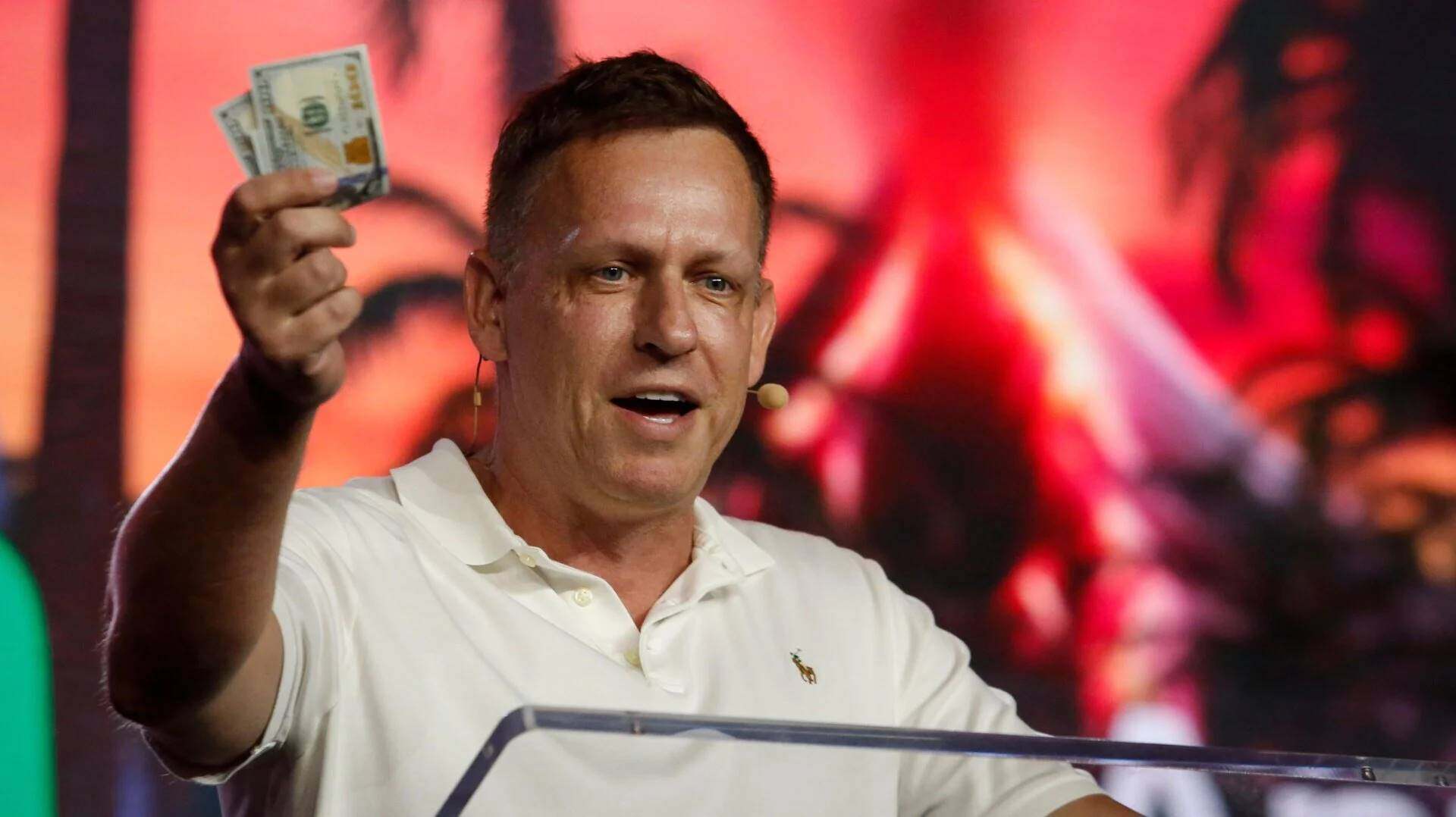
But Peter Thiel is more than just a savvy cryptocurrency trader. While buying and selling Bitcoin, he’s systematically investing in the entire crypto ecosystem:
Trading Infrastructure: In 2018, Founders Fund led an investment in Tagomi Systems, a company that provides cryptocurrency trading services to institutional investors. Tagomi addresses trading slippage by aggregating liquidity from multiple exchanges. In 2020, Coinbase acquired Tagomi for $150 million.
In 2021, Thiel personally invested in Bullish, an institutional-grade crypto exchange operated by Block.one. Bullish is unique in that it prioritized compliance from the outset, securing licenses in multiple jurisdictions. In July 2025, Bullish officially filed for an IPO, with a valuation exceeding $9 billion.
-Lending and DeFi: Valar Ventures (another fund of Thiel) invested in BlockFi in 2019, which was once one of the largest crypto lending platforms; but BlockFi eventually went bankrupt in 2022.
In 2023, when the market was at its lowest, Founders Fund invested in Ondo Finance. The RWA track, which was ignored at the time, had become the hottest direction in the encryption field by 2025.
-Project Incubator: In October 2023, Founders Fund also invested in Alliance DAO, acquiring a minority stake and providing support to companies in which Alliance DAO invests. Alliance DAO is currently one of the largest incubators in the crypto industry and an early backer of star projects such as Pump.fun.
European Expansion: Through connections in Germany, Thiel invested in Bitpanda, Austria's largest cryptocurrency exchange. In 2021, it was valued at $4.1 billion, making it Europe's most valuable crypto unicorn.
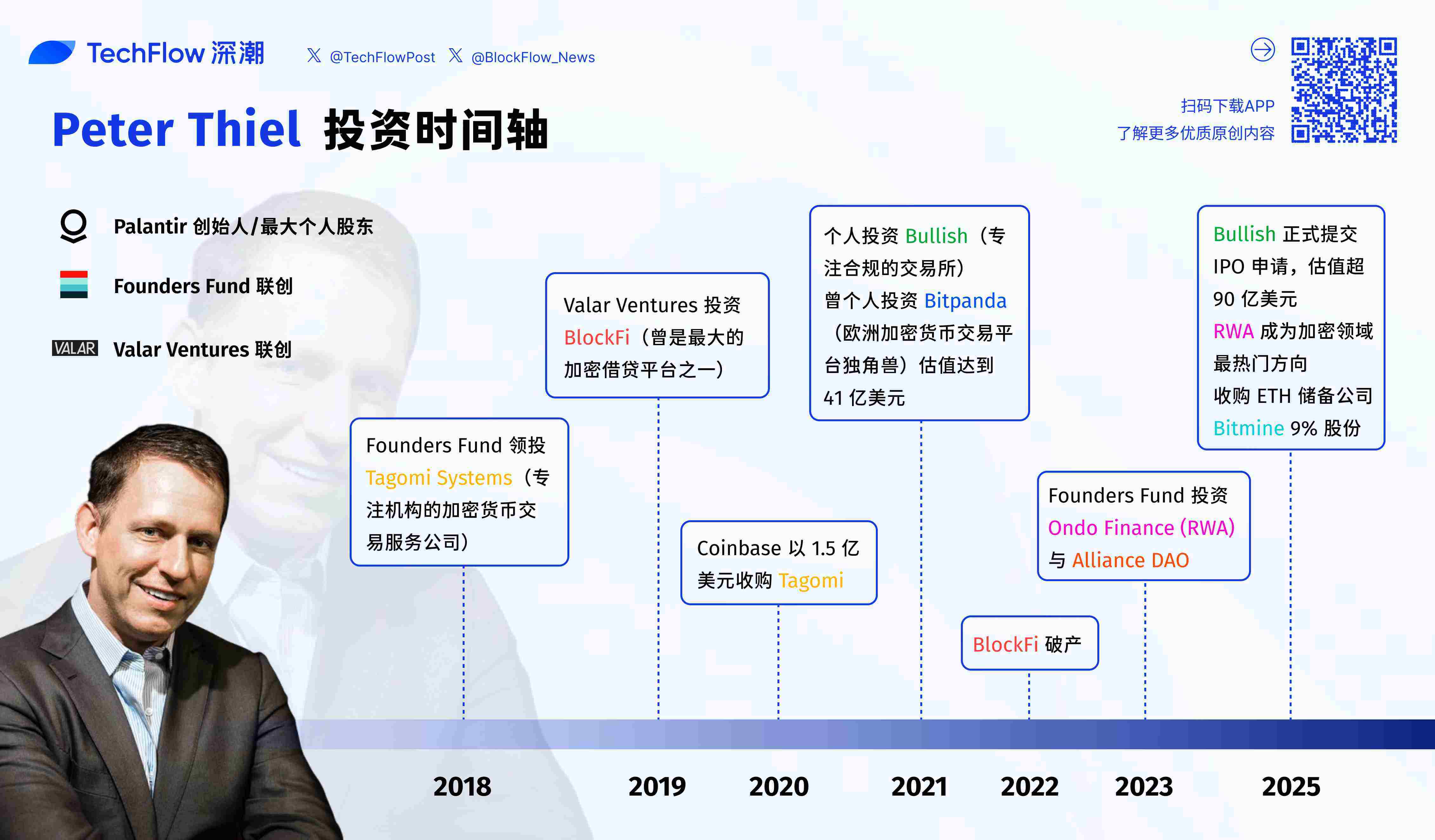
In the summer of 2023, Bitcoin lingered below $30,000 for several months. FTX's bankruptcy trial was ongoing, the SEC's crackdown on the crypto industry intensified, and the mainstream media was filled with claims of "crypto's death."
When everyone was fleeing, Founders Fund came back.
According to a Reuters report in February 2024, the fund bought $200 million worth of Bitcoin and Ethereum in batches from late summer to early autumn of 2023, half each.
Time has once again proved Thiel's judgment.
In January 2024, the SEC approved a Bitcoin spot ETF. Within months, over $50 billion in institutional funds poured in. By August 2025, Bitcoin surpassed $117,000 and Ethereum exceeded $4,000. Founders Fund's $200 million investment yielded a paper profit of over 100%.
On July 16 of this year, Bitmine announced that Peter Thiel's Founders Fund purchased 9.1% of its shares.
Looking back at every stage of Peter Thiel's crypto journey, from escaping the market's peak to investing in stocks and navigating market trends, he's mostly hit the right notes. Publicly, he's a Bitcoin evangelist; in practice, he's a true practitioner of contrarian thinking.
As of August 2025, according to various estimates, Thiel has accumulated profits of more than US$2.5 billion through cryptocurrencies: US$1.8 billion from escaping the peak in 2022, US$500 million from exiting early investment projects, and US$200 million from bottom-fishing in 2023.
This does not include his Bullish shares, Bitpanda equity, and the latest BMNR investment.
Binding to the American destiny
In addition to investing in the PayPal mafia, Thiel actually founded his own company after leaving PayPal in 2003 - Palantir, a company that serves the government and military and develops intelligence systems for them.
What was the mainstream in Silicon Valley at the time? Social networks, e-commerce, and search engines. And Thiel chose to do data analysis for the CIA.
Palantir's first $2 million in seed funding came from In-Q-Tel, the CIA's venture capital arm, and Thiel himself invested $30 million. The company's name was inspired by the "Palantir," the philosopher's stone from The Lord of the Rings that can see through everything.
There was almost no public coverage for the next seven years. It wasn't until the 2010 Afghanistan War and the 2011 assassination of Osama bin Laden that the media learned that Palantir's intelligence analysis system played a key role.
The company Thiel founded had a client list resembling the cast of a spy film: the CIA, the FBI, the NSA, the Pentagon. But in Silicon Valley, a place known for its liberal values, this made Palantir a target of public criticism. Protesters demonstrated outside its offices, calling it an "evil corporation." Recruiting staff became difficult, and commercialization repeatedly encountered obstacles.
When it went public in 2020, Wall Street wasn't impressed. The company hadn't been profitable for years and was overly dependent on government contracts. Its stock price plummeted from $10 to $5.92.
After the ChatGPT explosion in 2023, Palantir launched the AIP platform, combining 20 years of intelligence analysis capabilities with popular large language models to serve more internal process management in enterprises. When Google withdrew from the Pentagon AI project due to employee protests, Palantir took over.
Subsequently, military orders began to surge: in 2024, the US Army signed a 10-year, $10 billion contract with it; in April 2025, NATO officially purchased the Maven Smart System developed by it.
At the same time, the company's stock price soared from US$6 at the beginning of 2023 to US$187 in August 2025, and its total market value reached US$440 billion, which has exceeded the combined market value of the three traditional US military giants.
Palantir's true value lies beyond its stock price. The company's systems connect every node of American power: the Department of Homeland Security uses them to track immigrants, the SEC uses them to investigate insider trading, and the IRS uses them to conduct tax audits.
When JD Vance, whom Thiel promoted, became Vice President, Palantir's government contracts increased significantly. Thiel influences policymaking through Vance, participates in power dynamics through Palantir, and controls Silicon Valley through the PayPal mafia. The synergistic effects of this power network are only beginning to emerge.
From the initial investment of 30 million in 2003 to the market value of 440 billion today, for Thiel, Palantir brings not only wealth, but also a pass to the core of power in Washington.
Choosing to work for the CIA 20 years ago seemed like the most unlikely move in Silicon Valley at the time. Looking back today, it may have been Thiel's most astute strategy.
It’s not too late to create a king in Silicon Valley in ten years
In August 2025, the second most powerful person in the United States will be the man who called Trump "Hitler" four years ago.
JD Vance, 39, is one of the youngest vice presidents in U.S. history.
From Yale Law School to Silicon Valley, from best-selling author to senator to vice president, Peter Thiel has always been behind this incredible trajectory.
In 2011, Peter Thiel was invited to give a speech at Yale Law School, where he criticized elite institutions for their excessive focus on peer competition and the blind pursuit of climbing the ladder of prestige. JD Vance, sitting in the audience, was deeply moved and met Thiel.
Years later, he wrote that this speech was "the most important moment at Yale," and it also changed the trajectory of Vance's life.
After graduating from Yale in 2013, he joined the top law firm Sidley Austin as expected. But after just two years, he resigned. His next stop was Circuit Therapeutics, a biotech startup in Silicon Valley, where he became director of operations.
For a lawyer with no background in technology, this was a huge jump. Circuit CEO Frederic Moll later admitted to the media that Vance was hired partly because of Peter Thiel's recommendation.
Thiel's venture capital fund had invested in Moll's previous company, a Silicon Valley-style favor. In 2016, Vance's career took another turn. He joined Peter Thiel's venture capital fund, Mithril Capital, as a partner.
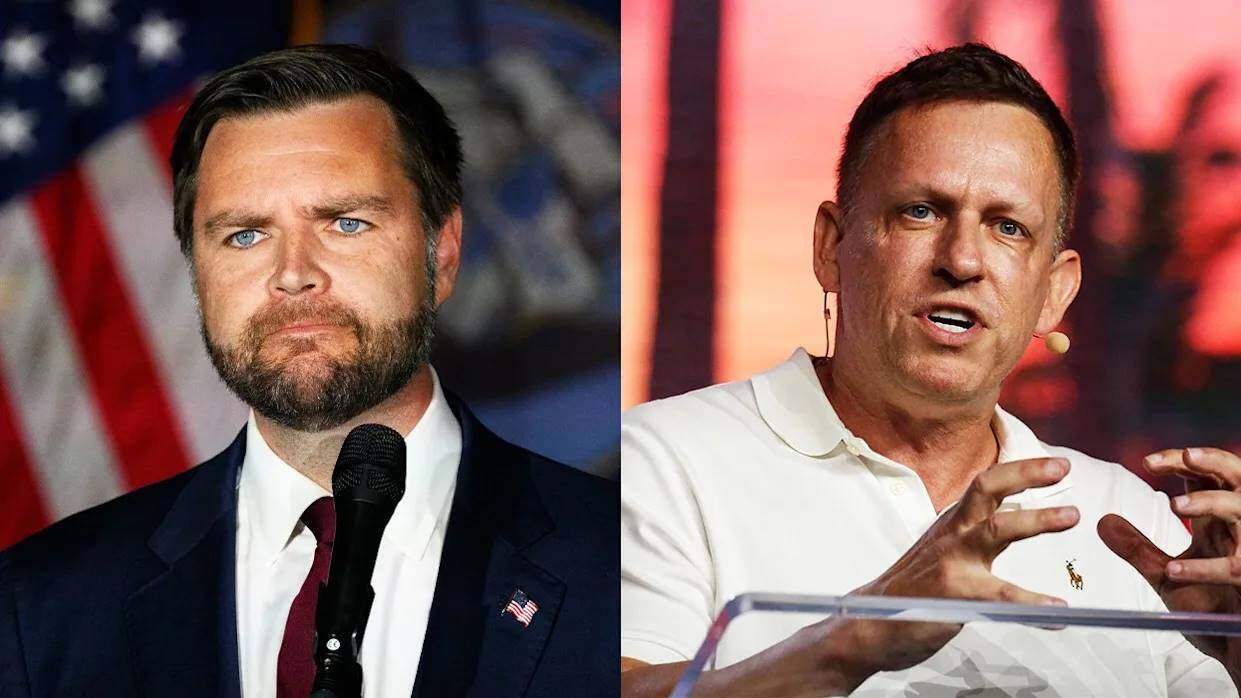
In July of the same year, his memoir, Hillbilly Elegy, was published and quickly topped the New York Times bestseller list. Suddenly, this little-known venture capital partner became a nationally renowned writer and cultural commentator.
According to a 2024 report in the Wall Street Journal, Mithril's former colleagues recalled that during Vance's year in office, he was rarely seen in the office; he spent most of his time traveling around the country for book signings, speeches, and interviews.
But this seems to be exactly what Thiel wants, not to train an investment manager but to create a public intellectual.
In March 2017, Vance left Mithril Fund, but he did not leave Peter Thiel's orbit. He first joined AOL founder Steve Case's Revolution Fund, and then founded his own fund Narya Capital in 2019.
Narya's investor list says it all: the lead investor is none other than Peter Thiel, and follow-up investors include a16z founder Marc Andreessen and former Google CEO Eric Schmidt.
In 2021, when Vance announced his candidacy for the Ohio Senate, Thiel donated $15 million to Protect Ohio Values, a super PAC supporting Vance, according to public records from the Federal Election Commission. This was the largest single donation by an individual to a Senate campaign in history.
Peter Thiel wasn't alone. His friend David Sacks donated $1 million, and other Silicon Valley figures followed suit. Ultimately, donations from the tech industry accounted for the majority of Vance's campaign funds. An Ohio Senate seat became a target for Silicon Valley capital.
It took Vance less than two years from being elected as a senator in November 2022 to being nominated as a vice presidential candidate in July 2024. This speed is extremely rare in American political history.
Multiple media outlets have reported that Silicon Valley voices were remarkably consistent during Trump's selection of a running mate, with not only Peter Thiel but also Elon Musk, David Sacks, and others recommending Vance.
These tech tycoons see not just a vice president, but their voice in Washington.
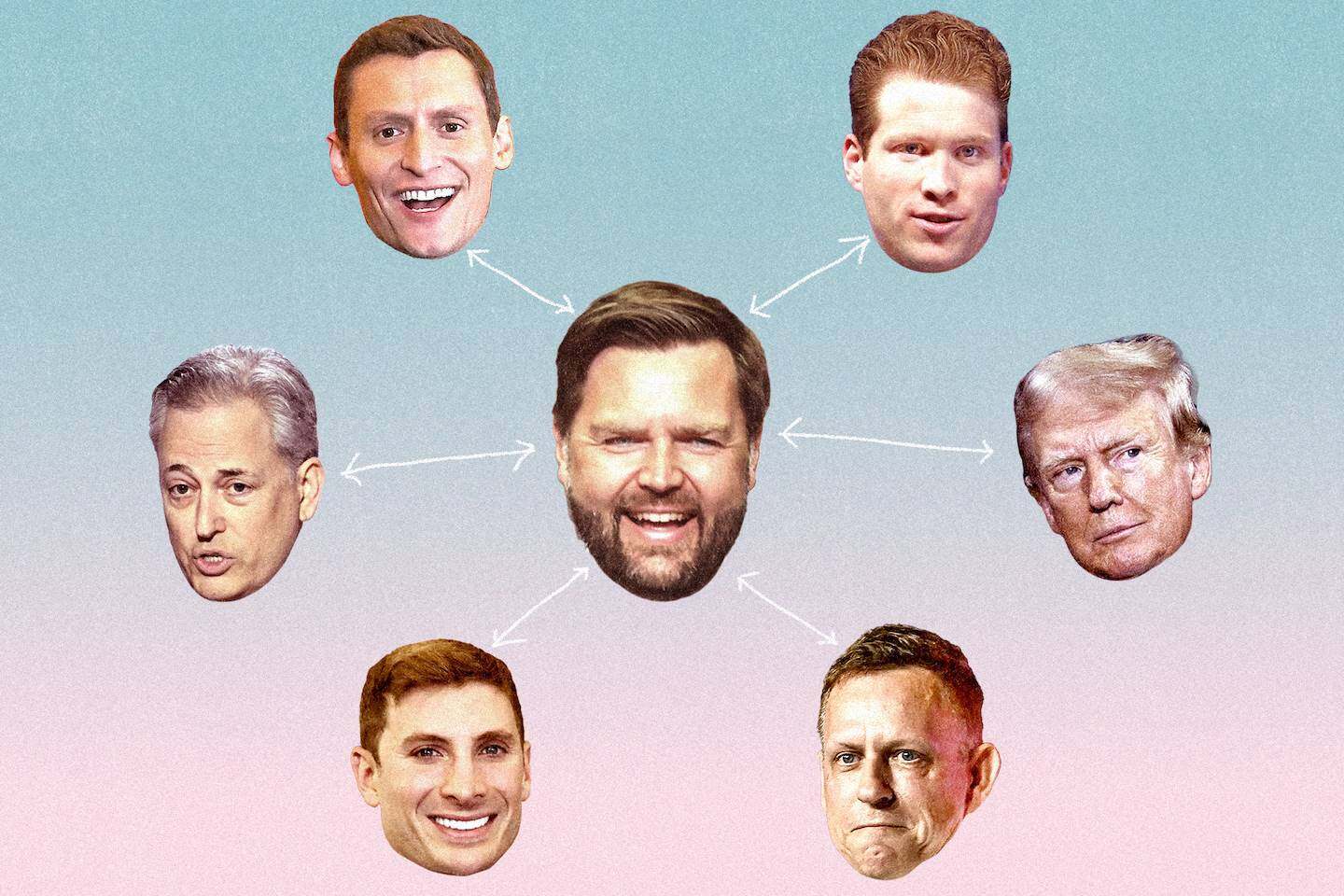
JD Vance's Silicon Valley network | Source: The Washington Post
Clockwise from top left: Blake Masters, Joe Lonsdale, Peter Thiel, Jacob Helberg, David Sacks
After Vance took office, policies began to shift.
The federal government has increased its purchases of AI and data analysis tools, with Peter Thiel's Palantir becoming the main beneficiary; at the same time, the US government's regulatory stance on cryptocurrencies has clearly softened.
These changes may not be directly attributable to Thiel's influence, but the timing is thought-provoking.
Thiel's relationship with Vance may also represent a new model for political influence. Unlike traditional lobbying or political donations, it's more like a venture capital-style nurturing approach: identifying promising talent early on, providing financial and resource support to help them gain power, and then achieving long-term influence through ideological resonance.
At 39, Vance likely has decades of political life ahead of him, which means Thiel's influence extends far beyond a typical election cycle.
“What important truth do you believe that most people don’t agree with?”
Perhaps for Peter Thiel, the answer has always been simple: power never belongs to those in the spotlight.



